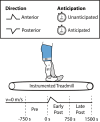The effects of anticipation of standing surface translations on distal leg muscle excitations
- PMID: 40232512
- PMCID: PMC12000272
- DOI: 10.1007/s00221-025-07075-y
The effects of anticipation of standing surface translations on distal leg muscle excitations
Abstract
This study aimed to investigate the interactions between anticipation and direction of surface translations applied during standing on distal leg muscle excitations measured via surface electromyography (EMG) in the context of resultant changes in center of mass (CoM) displacements. Twenty young adults experienced four combinations of surface translations (i.e., anticipated anterior, unanticipated anterior, anticipated posterior, unanticipated posterior) via a dual-belt instrumented treadmill. For each condition, a 200 ms, 6 m/s2 anterior or posterior perturbation was delivered either unexpectedly or after a three-second verbal countdown. Each condition was repeated three times in a randomized order. We recorded surface EMG from the MG, SOL, and TA, and motion capture collected pelvis displacements as a surrogate for CoM. Data were analyzed across three time periods: pre-perturbation, early post-perturbation, and late post-perturbation. Direction-dependent EMG responses were as hypothesized, with TA iEMG increasing by 81% following anterior perturbations and MG and SOL iEMG increasing by 60% and 32% respectively following posterior perturbations. As hypothesized, anticipated balance challenges elicited greater proactive iEMG for all muscles. However, only unanticipated anterior perturbations elicited greater reactive TA iEMG than anticipated anterior perturbations. These proactive neuromechanical adjustments, particularly for anterior surface translations that would precipitate a backward fall, appeared protective and effective based on resultant patterns of CoM displacements. These data serve as a reference for understanding how aging and disease impact proactive and reactive postural control, especially for populations who may have difficulty with both the planning and execution of corrective neuromuscular adjustments.
Keywords: Anticipatory postural adjustments; Falls; Neuromechanics; Posture; Reactive postural adjustments.
© 2025. The Author(s).
Conflict of interest statement
Declarations. Ethical approval: This study was performed in line with the principles of the Declaration of Helsinki. Approval was granted by the University of North Carolina Biomedical Sciences Institutional Review Board. Consent to participate: Informed consent was obtained from all individual participants included in the study. Competing interests: The authors declare no competing interests.
Figures




Similar articles
-
Anticipation augments distal leg muscle neuromechanics before, during, and after treadmill-induced perturbations applied during walking.J Biomech. 2025 Mar;181:112547. doi: 10.1016/j.jbiomech.2025.112547. Epub 2025 Jan 21. J Biomech. 2025. PMID: 39884062
-
Vestibular influences on human postural control in combinations of pitch and roll planes reveal differences in spatiotemporal processing.Exp Brain Res. 2001 Sep;140(1):95-111. doi: 10.1007/s002210100802. Exp Brain Res. 2001. PMID: 11500802
-
Responses of leg muscles in humans displaced while standing. Effects of types of perturbation and of postural set.Brain. 1990 Feb;113 ( Pt 1):65-84. doi: 10.1093/brain/113.1.65. Brain. 1990. PMID: 2302538
-
External postural perturbations induce multiple anticipatory postural adjustments when subjects cannot pre-select their stepping foot.Exp Brain Res. 2007 May;179(1):29-42. doi: 10.1007/s00221-006-0763-5. Epub 2006 Nov 8. Exp Brain Res. 2007. PMID: 17091288
-
Postural responses triggered by multidirectional leg lifts and surface tilts.Exp Brain Res. 2005 Aug;165(2):152-66. doi: 10.1007/s00221-005-2295-9. Epub 2005 Jun 7. Exp Brain Res. 2005. PMID: 15940494
References
-
- Bastian AJ (2006) Learning to predict the future: the cerebellum adapts feedforward movement control. Curr Opin Neurobiol 16:645–649. 10.1016/j.conb.2006.08.016 - PubMed
-
- Bhatt T, Wening JD, Pai Y-C (2006) Adaptive control of gait stability in reducing slip-related backward loss of balance. Exp Brain Res 170:61–73. 10.1007/s00221-005-0189-5 - PubMed
-
- Chambers AJ, Cham R (2007) Slip-related muscle activation patterns in the stance leg during walking. Gait Posture 25:565–572. 10.1016/j.gaitpost.2006.06.007 - PubMed
-
- Christensen LOD, Petersen N, Andersen JB et al (2000) Evidence for transcortical reflex pathways in the lower limb of man. Prog Neurobiol 62:251–272. 10.1016/S0301-0082(00)00007-1 - PubMed
MeSH terms
Grants and funding
LinkOut - more resources
Full Text Sources
Research Materials

